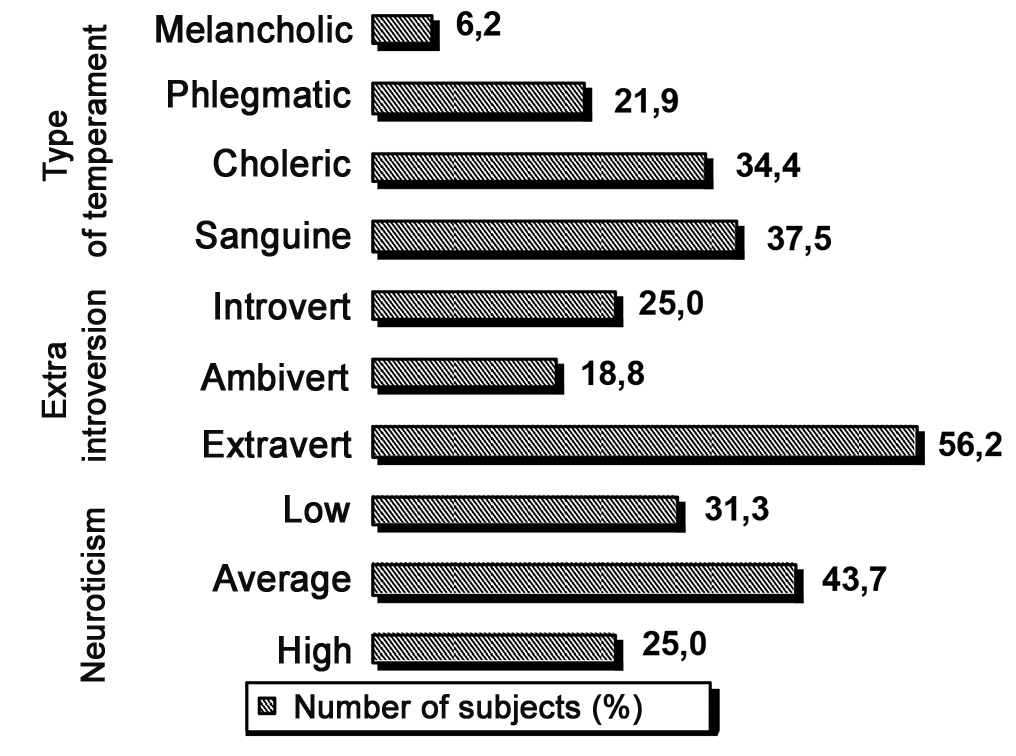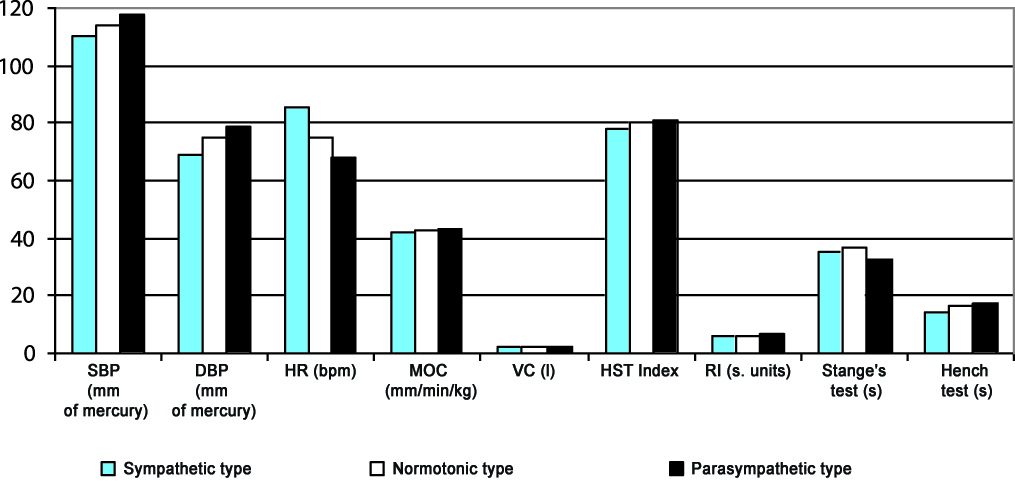Outline and focus of female gymnasts' individualized training process for balance beam exercises at advanced specialization stage
Фотографии:
ˑ:
Dr.Hab., Professor A.A. Gorelov1
E.N. Artemova2
Dr.Hab., Professor O.G. Rumba1
1Saint-Petersburg State Polytechnic University, St. Petersburg
2Holmen Tropp Gymnastics Club, Norway, Asker
Keywords: balance beam exercises at advanced specialization stage, individualized workout sessions, anthropometry, neurodynamic properties, functional status, physical working capacity, motor characteristics, technical competency.
Introduction. The principle of individualization serves as a foundation for elective education and ensures motivation mindset, intensification of workout sessions, personal communication between a coach and a student. It is directed towards adaptation of the training means and methods to the individual characteristics of an athlete. Its use is determined by the need to fully realize an individual’s potential to fulfill his best abilities. Moreover, individualization is a specific tool of diverse and multi-dimensional analysis of all the abilities a person has, which ensures realization of his/her uniqueness and originality [1 et al.].
The results of the research studies at individualized workout sessions on the balance beam obtained by Korenberg V.B., Lyuik L.V., et al. [3,4] mostly touch upon the problems of domination of certain typological properties of the nervous system, anthropometric indicators, motor abilities, ability to assimilate complex locomotions. However, they are focused only on the causes which decrease the reliability of exercises done on this gymnastic apparatus, focusing on insufficient physical, technical and psychological readiness, mistakes in the teaching methodology, etc.
They precondition the topicality of the individualization problem in women's gymnastics and a burning need for experimental research studies aimed at determining the specifics of workout sessions in beam exercises given the individual characteristics of female gymnasts.
Research structure and methods. 32 female gymnasts aged 10-11 years and having the sport qualification ‘1st category’ participated in the research studies, which were carried out for one year at the premises of Specialized Children and Youth Sports School of the Olympic Reserve # 3, the town of Belgorod. All the subjects went through anthropometric testing, testing of neurodynamic and some other properties of the nervous system, testing of functional condition, physical efficiency, and level of motor qualities.
Research results and discussion. According to the studied anthropometric indicators of female gymnasts, three groups have been singled out, each of them characterizing one or another somatic type. 46.9% of the total number of the female gymnasts included in the study sample were assigned to the microsomatic type (MiS). 40.6% referred to the mesosomatic group (MeS). The share of the macrosomatic group (MaS) was 12.5%. It can be concluded that the MaS type is less common for female gymnasts in comparison to the MiS and MeS types.
The testing results of the neurodynamic qualities of female gymnasts distributed the study sample in the following way: 37.5% of sanguine temperament, 34.4% of choleric one, 21.9% of phlegmatic one and 6.2% of melancholic one. There are 56.2% of extraverts, 25.0% of introverts, 18.8% of ambiverts. High level of neuroticism is common for 31.3% of the study sample, it is average for 43.7% and 25% and low for 25% (Fig. 1). Moreover, some research studies in sport psychology prove that a moderate degree of neuroticism is not a negative personality trait or a failure factor in a competition, which is why it can be attributed to a natural specific feature of girls in this age group.

Fig. 1. Neurodynamic qualities of the female gymnasts under study
The analyzed testing results of some properties of the nervous system (NS) have shown that 43.75% have a strong NS, 25.00% have an average one and 31.25% have a weak nervous system. This proves the dominance of girls with a strong type of the NS in the studied contingent. It also proves the presence of a “typological profile” among gymnasts [2].
The studied parameters of simple (SSMR) and complex sensomotor reaction (CSMR) have revealed that the duration of SSMR is reliably lower among the female gymnasts with a weak type of the NS (245.0±0.01 msec, r<0.05). At the same time, CSMR is lower among the female gymnasts with a strong type of the NS (338.0±0.02 msec) and reliably higher (r<0,05) in comparison to the female gymnasts with an average type of the NS. It can be explained by the fact that CSMR includes two components: time of simple reaction and time of ‘central delay’, i.e. time spent on differentiation of signals and time spent on taking a decision about response to them [2].
For the gymnasts with a strong type of the NS a higher speed of psychomotor processes (SPMP) is common. Thus, according to a tapping test, compared with the subjects with a weak type of the NS, the reliability of differences was at 99% level of significance, those with an average one – at 95% level.
The subjects with a weak NS had a higher level of trait anxiety (47.7±4.3 c.u.) and state anxiety (46.2±5.2 c.u.) in comparison to the gymnasts whose NS was average or strong (r<0.05). A higher level of ambition for high achievements was identified among the gymnasts with the strong type of the NS (15.0±1.0 c.u.).
The study of the functional status of the vegetative NS (Fig. 2) according to Kerdo’s index in the representatives of the sympathetic type (28.1%) of vegetative regulation (VR) revealed lower values of the systolic (SBP) and diastolic blood pressure (DBP). It is common for them to have higher values of resting heart rate in comparison to the same indicators of the female gymnasts with the prevailing normotonic and parasympathetic types of VR. For the gymnasts belonging to the parasympathetic type of VR (12.5%), higher values of SBP and DBP and lower values of resting heart rate are common. Most of the subjects (59.4%) belong to the normotonic type.
The functional status of the cardiovascular system (CVS) was researched via calculation of the Ruffier index (RI). The results show that higher values are common for the gymnasts with the sympathetic type of VR (5.9±1.5 s. units). These indicators are somewhat lower for the representatives of the nomotonic and parasympathetic types of VR (6.3±1.7 s. units and 6.7±1.2 s. units, respectively).

Fig. 2. Characteristic of the functional status of gymnasts aged 10-11 years with various types of vegetative regulation.
Research of the physical working capacity of the gymnasts showed that it is approximately the same for the gymnasts of all VR types, with insignificant prevalence among the representatives of the parasympathetic VR type (r>0.05). A similar trend is true for the indicators of maximum oxygen consumption (MOC), lung capacity (LC), expiration breath-holding time (Hench test).
According to the results of basic physical qualities testing, all the gymnasts were conditionally divided into three groups: ‘endurance’, ‘strong’ and ‘all-round'.
It was preconditioned by the fact that low and high levels of physical fitness reflect either predisposition to a certain type of movements or to their absence, which to a certain degree is preconditioned by genetic factors, i.e. heritability [5].
The female gymnasts referred to the ‘endurance’ group (25.0%) demonstrated better results in 6 minute run (1140.80±12.4 m) and flexibility exercise (9.36±0.1 points) in comparison with other groups (r<0.05). In terms of other indicators examined they were approximately at the same level.
The ‘all-round' female gymnasts (46.9%) were in between ‘endurance’ and ‘strong’ ones and their level can be characterized as low. The ‘strong’ gymnasts (28.1%), in comparison to those from other groups, showed better results in standing long jumps and high jumps, 20 m run, half lever position, hip swing ups on bars (number of reps), jump test (p<0.05).
Conclusion. Thus, the represented data give evidence about inhomogeneity of the test groups and preconditions the need for differentiated approach to workout sessions of female gymnasts in the balance beam exercises.
Complex interpretation of the above data in the context of individual specifics of female gymnasts belonging to one or another somatotype allowed characterizing each group in the following way:
representatives of the microsomatic type of constitution are characterized by prevailing sympathetic tonus of vegetative regulation, low level of trait anxiety, high ambition for success, quite high level of the developed speed and strength qualities. Most of the female gymnasts are extraverts, and, by the type of temperament they are sanguine and choleric;
- for the representatives of the mesosomatic type, it is more common to have a higher (in comparison to other groups) level of speed and strength qualities, normotonic type of vegetative regulation, moderate level of trait and state anxiety. No prevailing temperament type has been identified.
- female gymnasts, referred to the macrosomatic type, are taller and have longer limbs (comparing to the representatives of other groups), parasympathetic tonus of vegetative regulation prevails, the level of speed and strength qualities is lower, and their aerobic endurance is relatively high. Most of the gymnasts are introverts and phlegmatic by the type of temperament.
References
- Vrublevskiy E.P. Nauchno-metodicheskie osnovy individualizatsii trenirovochnogo protsessa sportsmenok v skorostno-silovykh vidakh legkoy atletiki [Scientific-methodical basics of individualization of female strength-speed athletes' training process]. Smolensk: SSAPCST publ., 2008, 340 p.
- Ilyin E.P. Psikhologiya sporta [Sports Psychology]. St. Petersburg: Piter publ., 2008, 352 p.
- Korenberg V.B. Uprazhneniya na brevne. Gimnasticheskoe mnogoborie [Balance beam exercises. All-Around Gymnastics]. Moscow Fizkultura i sport publ., 1986, 124 p.
- Lyuyk L.V. Programmirovannoe obuchenie slozhnym akrobaticheskim soedineniyam na brevne. Avtoref. dis. kand. ped. nauk [Programmed teaching complex acrobatic beam combinations. PhD diss. abstract]; Lesgaft SIPC. Leningrad, 1991, 21 p.
- Sergienko L.P. Sportivny otbor: teoriya i praktika [Qualifying Athletes: Theory and Practice]. Moscow: Sovetskiy sport publ., 2013, 1048 p.
Corresponding author: piskun@imop.ru
Abstract
This paper is aimed to consider the issue of individualized workout sessions of female gymnasts exercising on the balance beam. The authors have analyzed the anthropometric data, neurodynamic properties, functional state parameters, physical working capacity indicators, level of technical skills of the highly qualified female gymnasts and have come to the conclusion that the latter ones have to be divided into certain typological groups. Each group is different in the preferential development of certain motor conditions, neurodynamic properties, type of vegetative regulation, levels of trait and state anxiety, and anthropometric features. Moreover, the authors have not identified any strong connections between the studied parameters. It is the evidence of individuality of the subjects and proves the absence of typological group specifics. The results confirm that individualized workout sessions on the balance beam are highly important and should be based on differentiated approach to every female gymnast.




